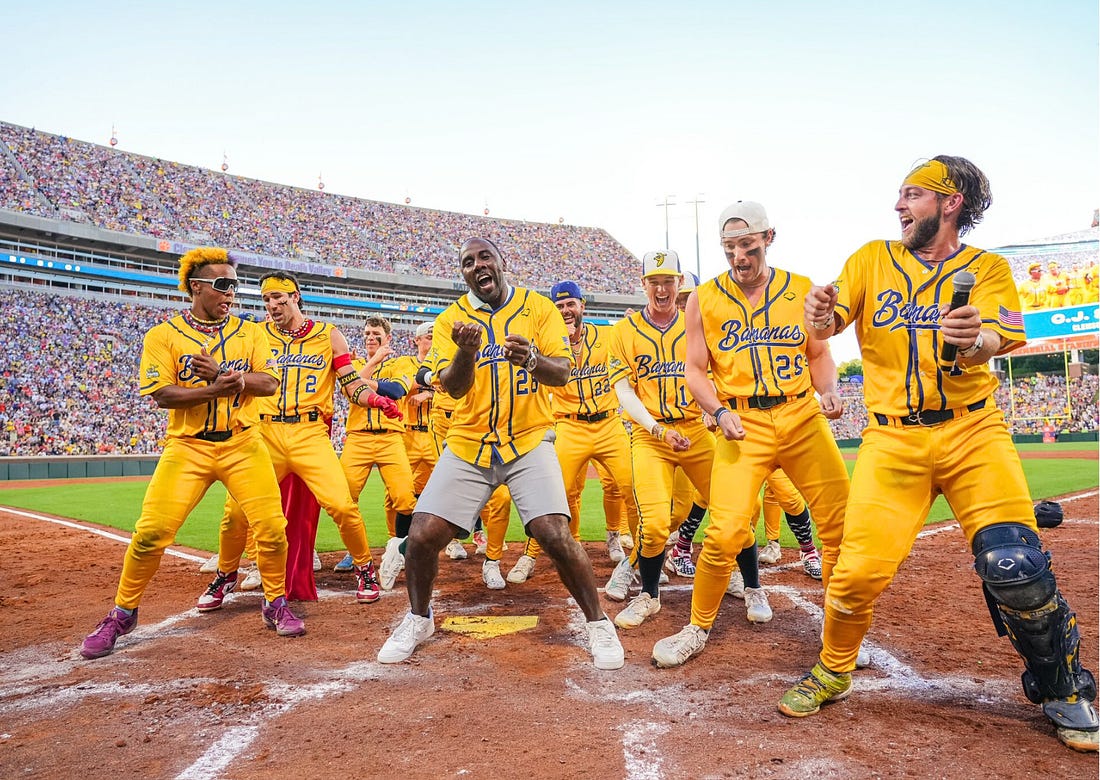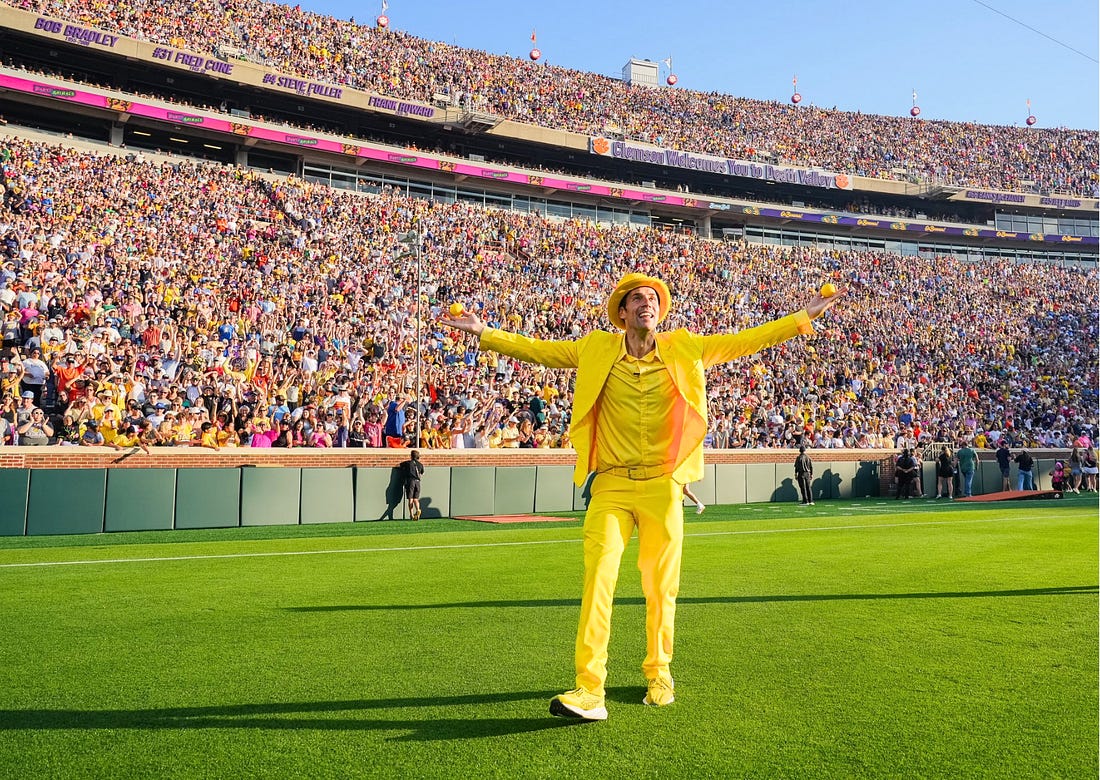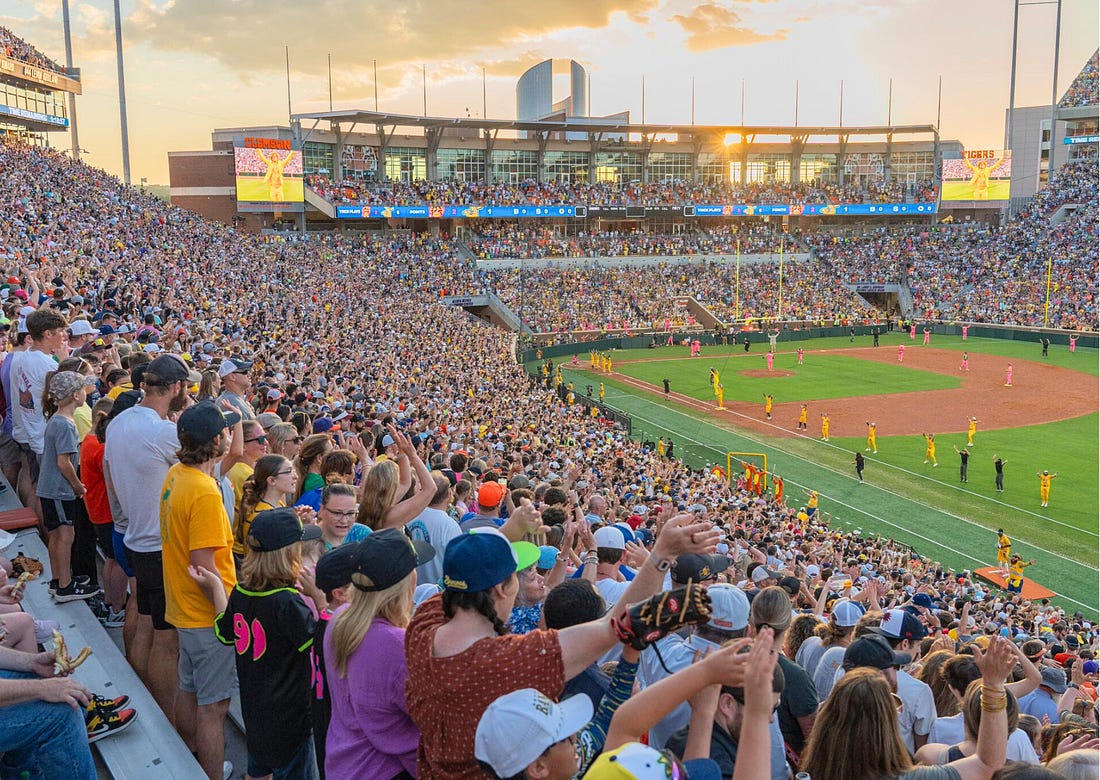Inside the Wild Rise of the Savannah Bananas: Baseball’s New Billion-Dollar Brand
Inside the Wild Rise of the Savannah Bananas: Baseball’s New Billion-Dollar BrandToday’s newsletter breaks down the Savannah Bananas 40-city tour, including the financial agreement for the team’s sold-out game at Clemson and why the future of Banana Ball could be even bigger.
The Savannah Bananas broke their all-time attendance record on Saturday night when a sold-out crowd of 81,000 people attended their game in Clemson’s football stadium. The game itself was unlike anything these people had ever seen. Broadcast nationally on ESPN2, the temporary 190-foot short porch in left field led to nearly a dozen home runs. There were mid-game dances and a halftime performance. Outfielders caught flyballs while doing backflips, and fans even helped record outs by catching foul balls. The Bananas have become baseball’s most polarizing team. Purists will tell you that it’s a silly idea, despite over a million fans showing up to their games last year. Others say that the Bananas are re-running the same playbook that made the Harlem Globetrotters so popular in the 20th century. But all of these people are wrong. The Bananas are something entirely different. Over the last decade, they have carefully constructed a cult-like following that could eventually be worth a billion dollars. The Savannah Bananas have hundreds of employees, and the team’s players have millions of followers. They sell more merchandise than professional sports teams, and the Bananas’ current tour includes 40 stops in 25 states, including games in 18 MLB stadiums and four football stadiums (Tampa Bay, Clemson, Nashville, and Charlotte). By 2026, the Bananas will operate a full-time league, featuring multiple teams, televised games on major networks, and tens of thousands of fans at each event. But here’s the most interesting part: Rather than hiring the country’s best consulting firms to maximize revenue by increasing margins, the Bananas leave a ton of money on the table. This is intentional. Owners Jesse Cole and his wife Emily have built the business by continuously asking themselves one question: What is best for the fans? We have discussed the Savannah Bananas a few times over the years, so I’ll save you the hour-long recap. What you need to know is that the Bananas represent everything great about sports. Jesse Cole met his wife Emily while working for a summer league baseball team. The team averaged 200 fans per game and had only $268 in its bank account, so Jesse began trying unique promotions to get the business back on track. I’m not talking about the standard $1 hot dog night or bark at the park; Jesse thought so far outside the box that he invented a new one. Jesse began inviting fans to throw out the first pitch at games. Players would dance between innings, and it became common to see grandmothers participating in beauty pageants on the field. Over the years, I have had the opportunity to get to know Jesse, and one thing I have learned is that he is deeply passionate about the entertainment industry. He has read hundreds, if not thousands of books on the world’s greatest brands, studying everyone from Disney to Amazon, Apple, the UFC, and even the Beatles and Grateful Dead. By spending thousands of hours studying the world’s best marketing strategies, Jesse learned to maniacally focus on customer satisfaction and always prioritize long-term vision over short-term profit. But most importantly, this inspired him to think bigger. This is why Jesse and his wife Emily decided to take their fan-first approach to the next level. They moved to Savannah, Georgia, signed a $20,000-per-year lease on a stadium, and convinced the Coastal Plain League to award them an expansion team. The first few years were incredibly difficult. Jesse and his wife went from $0 in debt to $1.8 million, forcing them to sell their house and move into a garage-turned studio apartment, where they slept on an air mattress to save money. The truth is that many people would have given up at this point — the new team only sold two season ticket packages in its first two months — but Jesse knew he had to stick to the plan. Huddle Up is a reader-supported publication. To receive new posts and support my work, consider becoming a free or paid subscriber. Jesse kicked off the fan-first initiative by letting fans name the team. He also removed all stadium advertising from the outfield wall, traditionally a key revenue source for minor league baseball teams. And then Jesse did the unthinkable: every ticket to a Bananas game would cost only $25, with unlimited concessions (hot dogs, burgers, popcorn, soft drinks, etc.) included in that price. The team also agreed to “pay your taxes” so that a $25 ticket truly costs $25, eliminating all additional fees at checkout. This business model drastically reduced the team’s margins, making it impossible to turn a profit without a ton of volume. In simple terms, every single sports executive would have called Jesse crazy at the time. But that was the point. The fan-first model was crazy enough to draw a sellout crowd of 4,000 fans for the Bananas’ first game. The idea then expanded from there. Jesse was so invested in the fan experience that he used to watch security camera footage of fans at games. When were they engaged? At what point did they stop paying attention? Why were people still leaving early? This is when Jesse changed the game, literally and figuratively. Jesse wrote down everything that he hated about baseball and agreed to do the exact opposite. Players stepping out of the box during an at-bat? Not allowed anymore. Walks? Boring. Players now sprint around the bases until every player on defense touches the ball. Banana Ball rules also call for a two-hour time limit. If a fan cleanly catches a foul ball, it counts as an out. There are no mound visits or bunting, and each team is allowed one golden batter, sending any hitter to bat at any spot once per game. These rules, combined with in-game dances and constant fan engagement, have made the Bananas baseball’s most popular team. The Bananas have a full-time, in-house production team that records videos throughout each game and quickly packages them for social media. As a result, the Bananas now have over 15 million followers on social media, including more TikTok followers than every MLB team combined. The Bananas still play home games at Grayson Stadium in Savannah. In fact, the team just extended its lease by receiving financial commitment from the city to complete stadium upgrades, including a turf field, a drainage system, and a larger scoreboard. However, the Bananas have become so popular over the last few years that ticket demand has compelled them to go on tour. Last year’s tour, for instance, sold over 1 million tickets, and things have gotten even crazier this year. The Bananas have already sold 2 million tickets this year and now have a waiting list of 3 million people. The economics at each tour stop are different, but let’s use this weekend’s game at Clemson as an example. Sportico obtained the agreement, which reveals that the Bananas rented the stadium at no charge. This required a revenue-sharing agreement with Clemson. In return for spending $150,000 to build out the field and manage the facility, including parking and security, Clemson received all net ticket revenue from premium and club seats and 500 complimentary general admission tickets. Given the up-front costs, this wasn’t a huge money-maker for Clemson. Instead, the idea is to get national exposure, proving that they can handle more non-NCAA events. Huddle Up is a reader-supported publication. To receive new posts and support my work, consider becoming a free or paid subscriber. As for the Bananas, the team’s per-game financials aren’t known. What we do know, though, is that they generate tens of millions of dollars in merchandise sales each year. And the same can be said for tickets. The team only charges $25 to $60 for tickets on the primary market. But if you multiply 2 million tickets sold at the lowest price of $25, the Bananas will still generate $50 million in ticket sales during this tour. These numbers are just an estimate, but the reality is that the actual number could be significantly higher. The team still pays all taxes on tickets and merchandise, meaning if a shirt is listed for sale at $30, fans are buying it for $30. I’m sure you have also seen many sports teams start to reduce concession prices, such as the Atlanta Falcons, Phoenix Suns, and Baltimore Orioles. Well, that idea came from the Bananas. The team realized early on that providing free food meant that families had a better time at the game, but also spent more money on merchandise, further marketing the team. The Bananas still don’t have any advertising signage throughout the stadium. They have attempted to address high prices on the secondary ticket market by developing their own resale platform, and the team has even sacrificed a significant amount of money on broadcasting rights. Media companies like ESPN have been trying for years to broadcast their games, but the Bananas only agreed after ESPN allowed them to 1) use their own production team and 2) keep streaming all the games live on YouTube. ESPN eventually agreed (because the Bananas have become too hard to ignore). The worldwide leader in sports will broadcast 10 of the team’s games this summer, including two on ESPN, eight on ESPN2, and all 10 on ESPN+ and Disney+. It sounds cliche to say, but every financial decision that the Bananas make is fan-first, prioritizing long-term growth over short-term profit. Some professional sports teams say this is their business model, but the Bananas are the only ones who actually do it. Despite receiving investment offers nearly every day, Jesse Cole and his wife still own 100% of the business. And while many people think the Bananas are just a single team that travels city to city entertaining fans, the real vision for the team is much bigger. Starting next year, the Savannah Bananas are launching a new league called the Banana Ball Championship League, or BBCL. The Bananas already have three other teams that they compete against — the Party Animals, Tailgaters, and Firefighters — but they will add two more teams to make it a six-team league. The league will follow a 60-game schedule, excluding playoffs, and has already generated significant player interest, with 6,000 applicants and over 200 minor league and college baseball players invited to attend tryouts in Savannah, Phoenix, Los Angeles, Philadelphia, and Texas. These tryouts will include hitting and fielding drills to determine a player’s talent. However, the perfect player possesses a combination of skills and showmanship. That’s because players are required to rehearse choreographed dance routines before games to ensure fans are always entertained and that no two shows are ever the same. So, no, the Savannah Bananas aren’t the Harlem Globetrotters. Despite being less than a decade old, the Bananas have organically built one of the largest fan bases in all sports. The on-field product may not be for everyone, but that’s okay. The Savannah Bananas have already sold out the Carolina Panthers stadium in Charlotte for two straight nights this summer, proving that putting your fans first is a winning strategy. If you enjoyed this breakdown, share it with your friends. Huddle Up is a reader-supported publication. To receive new posts and support my work, consider becoming a free or paid subscriber. You’re currently a free subscriber to Huddle Up. For the full experience, upgrade your subscription.
© 2025 |




